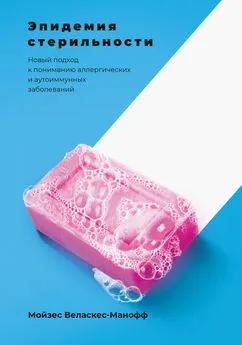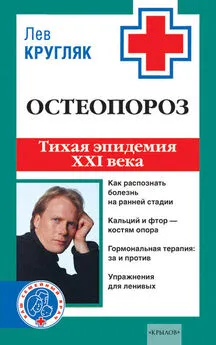Мойзес Веласкес-Манофф - Эпидемия стерильности
- Название:Эпидемия стерильности
- Автор:
- Жанр:
- Издательство:Манн, Иванов и Фербер
- Год:2019
- Город:Москва
- ISBN:978-5-00117-706-7
- Рейтинг:
- Избранное:Добавить в избранное
-
Отзывы:
-
Ваша оценка:
Мойзес Веласкес-Манофф - Эпидемия стерильности краткое содержание
Эпидемия стерильности - читать онлайн бесплатно ознакомительный отрывок
Интервал:
Закладка:
349
M. J. Blaser, S. Falkow. “What Are the Consequences of the Disappearing Human Microbiota?” Nature Reviews Microbiology 7, № 12 (2009).
350
M. J. Blaser. “Antibiotic Overuse: Stop the Killing of Beneficial Bacteria”. Nature 476, № 7361 (2011).
351
Anders Hviid, Henrik Svanström, Morten Frisch. “Antibiotic Use and Inflammatory Bowel Diseases in Childhood”. Gut 60, № 1 (2011).
352
Anna Lundgren et al. “Mucosal FOXP3-Expressing CD4+ CD25 High Regulatory T-cells Helicobacter pylori-infected Patients”. Infection and Immunity 73, № 1 (2005).
353
E. Marini et al. “Helicobacter pylori and Intestinal Parasites Are Not Detrimental to the Nutritional Status of Amerindians”. American Journal of Tropical Medicine and Hygiene 76, № 3 (2007).
354
M. G. Dominguez-Bello et al. “Amerindian Helicobacter pylori Strains Go Extinct, as European Strains Expand Their Host Range”. PLoS ONE 3, № 10 (2008).
355
Jeffrey I. Gordon, Todd R. Klaenhammer. “A Rendezvous with Our Microbes”. Proceedings of the National Academy of Sciences 108, Suppl. 1 (2011).
356
I. Mulder et al. “Environmentally-acquired Bacteria Influence Microbial Diversity and Natural Innate Immune Responses at Gut Surfaces”. BMC Biology 7, № 79 (2009).
357
Margaret McFall-Ngai. “Adaptive Immunity: Care for the Community”. Nature 445, № 7124 (2007).
358
Джастин Сонненберг перефразировал (процитировал) слова более раннего первопроходца в этой области, микробиолога Дуэйна Сэвиджа.
359
David A. Hill, David Artis. “Intestinal Bacteria and the Regulation of Immune Cell Homeostasis”. Annual Review of Immunology 28 (2010).
360
Размер теннисного корта для одиночной игры — 8,23 на 23,78 метра. Данные взяты из статьи: Kevin J. Maloy, Fiona Powrie. “Intestinal Homeostasis and Its Breakdown in Inflammatory Bowel Disease”. Nature 474, № 7351 (2011).
361
Karen Smith, Kathy D. McCoy, Andrew J. Macpherson. “Use of Axenic Animals in Studying the Adaptation of Mammals to Their Commensal Intestinal Microbiota”. Seminars in Immunology 19, № 2 (2007).
362
Цитата Пастера и многое другое почерпнуто из: B. S. Wostmann. “The Germfree Animal in Nutritional Studies”. Annual Review of Nutrition 1 (1981).
363
June L. Round, Sarkis K. Mazmanian. “Inducible FOXP3+ Regulatory T-cell Development by a Commensal Bacterium of the Intestinal Microbiota”. Proceedings of the National Academy of Sciences 107, № 27 (2010).
364
June L. Round, Sarkis K. Mazmanian. “The Gut Microbiota Shapes Intestinal Immune Responses during Health and Disease”. Nature Reviews Immunology 9, № 5 (2009).
365
I. I. Ivanov, D. R. Littman. “Segmented Filamentous Bacteria Take the Stage”. Mucosal Immunology 3, № 3 (2010).
366
Ivaylo I. Ivanov et al. “Gut-residing Segmented Filamentous Bacteria Drive Autoimmune Arthritis via T-Helper 17 Cells”. Immunity 32, № 6 (2010).
367
Yun Kyung Lee et al. “Microbes and Health Sackler Colloquium: Proinflammatory T-cell Responses to Gut Microbiota Promote Experimental Autoimmune Encephalomyelitis”. Proceedings of the National Academy of Sciences 108, Suppl. 1 (2011).
368
Daniel N. Frank et al. “Molecular-phylogenetic Characterization of Microbial Community Imbalances in Human Inflammatory Bowel Diseases”. Proceedings of the National Academy of Sciences 104, № 34 (2007).
369
Alexander Swidsinski et al. “Active Crohn’s Disease and Ulcerative Colitis Can Be Specifically Diagnosed and Monitored Based on the Biostructure of the Fecal Flora”. Inflammatory Bowel Diseases 14, № 2 (2008).
370
Harry Sokol et al. “Faecalibacterium prausnitzii Is an Anti-inflammatory Commensal Bacterium Identified by Gut Microbiota Analysis of Crohn’s Disease Patients”. Proceedings of the National Academy of Sciences 105, № 43 (2008).
371
Ben Willing et al. “Twin Studies Reveal Specific Imbalances in the Mucosa-associated Microbiota of Patients with Ileal Crohn’s Disease”. Inflammatory Bowel Diseases 15, № 5 (2009).
372
Koji Atarashi et al. “Induction of Colonic Regulatory T-cells by Indigenous Clostridium Species”. Science 331, № 6015 (2011).
373
Jussi Vaahtovuo et al. “Fecal Microbiota in Early Rheumatoid Arthritis”. Journal of Rheumatology 35, № 8 (2008).
374
Adriana Giongo et al. “Toward Defining the Autoimmune Microbiome for Type 1 Diabetes”. ISME Journal 5, № 1 (2011).
375
Глиадин — одна из составляющих глютена. Соответствующая диета обычно называется безглютеновой . Прим. ред.
376
Giada de Palma et al. “Intestinal Dysbiosis and Reduced Immunoglobulin-coated Bacteria Associated with Coeliac Disease in Children”. BMC Microbiology 10 (2010).
377
Jana Cinova et al. “Role of Intestinal Bacteria in Gliadininduced Changes in Intestinal Mucosa: Study in Germ-free Rats”. PLoS ONE 6, № 1 (2011).
378
Michael Wilson. Bacteriology of Humans: An Ecological Perspective. Malden: Blackwell Publishers, 2008, 202.
379
Rocío Martín et al. “Isolation of Bifidobacteria from Breast Milk and Assessment of the Bifidobacterial Population by PCR-denaturing Gradient Gel Electrophoresis and Quantitative Real-time PCR”. Applied and Environmental Microbiology 75, № 4 (2009).
380
Pablo F. Perez et al. “Bacterial Imprinting of the Neonatal Immune System: Lessons from Maternal Cells?” Pediatrics 119, № 3 (2007).
381
R. Satokari et al. “Bifidobacterium and Lactobacillus DNA in the Human Placenta”. Letters in Applied Microbiology 48, № 1 (2009).
382
J. Bruce German et al. “Human Milk Oligosaccharides: Evolution, Structures and Bioselectivity as Substrates for Intestinal Bacteria”. Nestle Nutrition Workshop Series Paediatric Programme 62 (2008).
383
Merete Eggesbø et al. “Cesarean Delivery and Cow Milk Allergy/Intolerance”. Allergy 60, № 9 (2005); Merete Eggesbø et al. “Is Delivery by Cesarean Section a Risk Factor for Food Allergy?” Journal of Allergy and Clinical Immunology 112, № 2 (2003). В ходе этого исследования не обнаружено никакой связи между пищевой аллергией и рождением ребенка при помощи кесарева сечения. Bente Kvenshagen, Ragnhild Halvorsen, Morten Jacobsen. “Is There an Increased Frequency of Food Allergy in Children Delivered by Caesarean Section Compared to Those Delivered Vaginally?” Acta Paediatrica 98, № 2 (2009).
384
C. Roduit et al. “Asthma at 8 Years of Age in Children Born by Caesarean Section”. Torax 64, № 2 (2009).
385
C. R. Cardwell et al. “Caesarean Section Is Associated with an Increased Risk of Childhood-onset Type 1 Diabetes Mellitus: A Meta-analysis of Observational Studies”. Diabetologia 51, № 5 (2008).
386
M. M. Grönlund et al. “Mode of Delivery Directs the Phagocyte Functions of Infants for the First 6 Months of Life”. Clinical and Experimental Immunology 116, № 3 (1999); M. M. Grönlund et al. “Fecal Microflora in Healthy Infants Born by Different Methods of Delivery: Permanent Changes in Intestinal Flora after Cesarean Delivery”. Journal of Pediatric Gastroenterology and Nutrition 28, № 1 (1999).
387
S. Salminen et al. “Influence of Mode of Delivery on Gut Microbiota Composition in Seven Year Old Children”. Gut 53, № 9 (2004).
388
Frederika A. van Nimwegen et al. “Mode and Place of Delivery, Gastrointestinal Microbiota, and Their Influence on Asthma and Atopy”. Journal of Allergy and Clinical Immunology 128, № 5 (2011).
389
Младенцев, родившихся путем кесарева сечения, колонизировали микробы, обитавшие на коже врачей и медсестер. Maria G. Dominguez-Bello et al. “Delivery Mode Shapes the Acquisition and Structure of the Initial Microbiota across Multiple Body Habitats in Newborns”. Proceedings of the National Academy of Sciences (2010).
390
Есть вероятность, что особенности людей, родившихся с помощью кесарева сечения, не имеют никакого отношения к микробиоте. Эти особенности могут быть обусловлены относительно низким уровнем стресса в случае хирургической операции — способа родов, по-видимому, оставляющего «отключенными» те клетки, которые должны были «включиться». T. Schlinzig et al. “Epigenetic Modulation at Birth — Altered DNA-methylation in White Blood Cells after Caesarean Section”. Acta Paediatrica 98, № 7 (2009).
391
Andrew Shreiner, Gary B. Huffnagle, Mairi C. Noverr. “The ‘Microflora Hypothesis’ of Allergic Disease”. Advances in Experimental Medicine and Biology 635 (2008).
392
J. S. Alm et al. “Atopy in Children of Families with an Anthroposophic Lifestyle” Lancet 353, № 9163 (1999); T. Alfvén et al. “Allergic Diseases and Atopic Sensitization in Children Related to Farming and Anthroposophic Lifestyle — the Parsifal Study”. Allergy 61, № 4 (2006).
393
Johan S. Alm et al. “An Anthroposophic Lifestyle and Intestinal Microflora in Infancy”. Pediatric Allergy and Immunology 13, № 6 (2002).
394
William Murk, Kari R. Risnes, Michael B. Bracken. “Prenatal or Early-life Exposure to Antibiotics and Risk of Childhood Asthma: A Systematic Review”. Pediatrics 127, № 6 (2011).
395
Cecilia Jernberg et al. “Long-term Ecological Impacts of Antibiotic Administration on the Human Intestinal Microbiota”. ISME Journal 1, № 1 (2007).
396
Les Dethlefsen et al. “The Pervasive Effects of an Antibiotic on the Human Gut Microbiota, as Revealed by Deep 16S rRNA Sequencing”. PLoS Biology 6, № 11 (2008).
397
Dionysios A. Antonopoulos et al. “Reproducible Community Dynamics of the Gastrointestinal Microbiota Following Antibiotic Perturbation”. Infection and Immunity 77, № 6 (2009).
Читать дальшеИнтервал:
Закладка:










